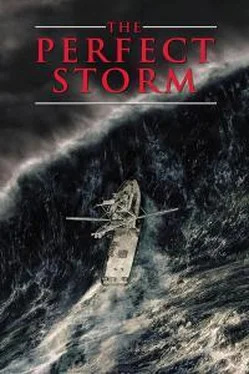Sebastian Junger - The Perfect Storm
Здесь есть возможность читать онлайн «Sebastian Junger - The Perfect Storm» — ознакомительный отрывок электронной книги совершенно бесплатно, а после прочтения отрывка купить полную версию. В некоторых случаях можно слушать аудио, скачать через торрент в формате fb2 и присутствует краткое содержание. Жанр: Триллер, Проза. Описание произведения, (предисловие) а так же отзывы посетителей доступны на портале библиотеки ЛибКат.
- Название:The Perfect Storm
- Автор:
- Жанр:
- Год:неизвестен
- ISBN:нет данных
- Рейтинг книги:3 / 5. Голосов: 1
-
Избранное:Добавить в избранное
- Отзывы:
-
Ваша оценка:
- 60
- 1
- 2
- 3
- 4
- 5
The Perfect Storm: краткое содержание, описание и аннотация
Предлагаем к чтению аннотацию, описание, краткое содержание или предисловие (зависит от того, что написал сам автор книги «The Perfect Storm»). Если вы не нашли необходимую информацию о книге — напишите в комментариях, мы постараемся отыскать её.
The Perfect Storm — читать онлайн ознакомительный отрывок
Ниже представлен текст книги, разбитый по страницам. Система сохранения места последней прочитанной страницы, позволяет с удобством читать онлайн бесплатно книгу «The Perfect Storm», без необходимости каждый раз заново искать на чём Вы остановились. Поставьте закладку, и сможете в любой момент перейти на страницу, на которой закончили чтение.
Интервал:
Закладка:
Whether the Andrea Gail rolls, pitch-poles, or gets driven down, she winds up, one way or another, in a position from which she cannot recover. Among marine architects this is known as the zero-moment point—the point of no return. The transition from crisis to catastrophe is fast, probably under a minute, or someone would've tripped the EPIRB. (In fact the EPIRB doesn't even signal when it hits the water, which means it has somehow malfunctioned. In the vast majority of cases, the Coast Guard knows when men are dying offshore.) There's no time to put on survival suits or grab a life vest; the boat's moving through the most extreme motion of her life and there isn't even time to shout. The refrigerator comes out of the wall and crashes across the galley. Dirty dishes cascade out of the sink. The TV, the washing machine, the VCR tapes, the men, all go flying. And, seconds later, the water moves in.
When a boat floods, the first thing that happens is that her electrical system shorts out. The lights go off, and for a few moments the only illumination is the frenetic blue of sparks arcing down into the water. It's said that people in extreme situations perceive things in distorted, almost surreal ways, and when the wires start to crackle and burn, perhaps one of the crew thinks of fireworks—of the last Fourth of July, walking around Gloucester with his girlfriend and watching colors blossom over the inner harbor. There'd be tourists shuffling down Rogers Street and fishermen hooting from bars and the smell of gunpowder and fried clams drifting through town. He'd have his whole life ahead of him, that July evening; he'd have every choice in the world.
And he wound up swordfishing. He wound up, by one route or another, on this trip, in this storm, with this boat filling up with water and one or two minutes left to live. There's no going back now, no rescue helicopter that could possibly save him. All that's left is to hope it's over fast.
When the water first hits the trapped men, it's cold but not paralyzing, around fifty-two degrees. A man can survive up to four hours in that temperature if something holds him up. If the boat rolls or flips over, the men in the wheelhouse are the first to drown. Their experience is exactly like Hazard's except that they don't make it out of the wheelhouse to a life raft; they inhale and that's it. After that the water rises up the companionway, flooding the galley and berths, and then starts up the inverted engine room hatch. It may well be pouring in the aft door and the fish hatch, too, if either failed during the sinking. If the boat is hull-up and there are men in the engine room, they are the last to die. They're in absolute darkness, under a landslide of tools and gear, the water rising up the companionway and the roar of the waves probably very muted through the hull. If the water takes long enough, they might attempt to escape on a lungful of air—down the companionway, along the hall, through the aft door and out from under the boat—but they don't make it. It's too far, they die trying. Or the water comes up so hard and fast that they can't even think. They're up to their waists and then their chests and then their chins and then there's no air at all. Just what's in their lungs, a minute's worth or so.
The instinct not to breathe underwater is so strong that it overcomes the agony of running out of air. No matter how desperate the drowning person is, he doesn't inhale until he's on the verge of losing consciousness. At that point there's so much carbon dioxide in the blood, and so little oxygen, that chemical sensors in the brain trigger an involuntary breath whether he's underwater or not. That is called the "break point”; laboratory experiments have shown the break point to come after eighty-seven seconds. It's a sort of neurological optimism, as if the body were saying, Holding our breath is killing us, and breathing in might not kill us, so we might as well breathe in. If the person hyperventilates first—as free divers do, and as a frantic person might—the break point comes as late as 140 seconds. Hyperventilation initially flushes carbon dioxide out of the system, so it takes that much longer to climb back up to critical levels.
Until the break point, a drowning person is said to be undergoing "voluntary apnea," choosing not to breathe. Lack of oxygen to the brain causes a sensation of darkness closing in from all sides, as in a camera aperture stopping down. The panic of a drowning person is mixed with an odd incredulity that this is actually happening. Having never done it before, the body—and the mind—do not know how to die gracefully. The process is filled with desperation and awkwardness. "So this is drowning," a drowning person might think. "So this is how my life finally ends."
Along with the disbelief is an overwhelming sense of being wrenched from life at the most banal, inopportune moment imaginable. "I can't die, I have tickets to next week's game," is not an impossible thought for someone who is drowning. The drowning person may even feel embarrassed, as if he's squandered a great fortune. He has an image of people shaking their heads over his dying so senselessly. The drowning person may feel as if it's the last, greatest act of stupidity in his life.
These thoughts shriek through the mind during the minute or so that it takes a panicked person to run out of air. When the first involuntary breath occurs most people are still conscious, which is unfortunate, because the only thing more unpleasant than running out of air is breathing in water. At that point the person goes from voluntary to involuntary apnea, and the drowning begins in earnest. A spasmodic breath drags water into the mouth and windpipe, and then one of two things happen. In about ten percent of people, water—anything—touching the vocal cords triggers an immediate contraction in the muscles around the larynx. In effect, the central nervous system judges something in the voice box to be more of a threat than low oxygen levels in the blood, and acts accordingly. This is called a laryngospasm. It's so powerful that it overcomes the breathing reflex and eventually suffocates the person. A person with laryngospasm drowns without any water in his lungs.
In the other ninety percent of people, water floods the lungs and ends any waning transfer of oxygen to the blood. The clock is running down now; half-conscious and enfeebled by oxygen depletion, the person is in no position to fight his way back up to the surface. The very process of drowning makes it harder and harder not to drown, an exponential disaster curve similar to that of a sinking boat.
Occasionally someone makes it back from this dark world, though, and it's from these people that we know what drowning feels like. In 1892 a Scottish doctor named James Lowson was on a steamship bound for Colombo, Sri Lanka, when they ran into a typhoon and went down in the dead of night. Most of the 150 people on board sank with the ship, but Lowson managed to fight his way out of the hold and over the side. The ship sank out from under his feet, dragging him down, and the last thing he remembers is losing consciousness underwater. A few minutes later the buoyancy of his life vest shot him to the surface, though, and he washed up on an island and lived to write about his experiences in the Edinburgh Medical Journal. He attributed the clarity of his recollection to the "preternatural calm" of people facing death. It's as close as one is going to get to the last moments of the Andrea Gail:
All afternoon the hammering of the big seas on the doomed vessel went on, whilst night came only to add darkness to our other horrors. Shortly before ten o'clock three tremendous seas found their way down the stokehole, putting out the fires, and our situation was desperate. The end came shortly before midnight, when there was a heavy crash on the reef, and the vessel was lying at the bottom of the Straits of Formosa in under a minute.
Читать дальшеИнтервал:
Закладка:
Похожие книги на «The Perfect Storm»
Представляем Вашему вниманию похожие книги на «The Perfect Storm» списком для выбора. Мы отобрали схожую по названию и смыслу литературу в надежде предоставить читателям больше вариантов отыскать новые, интересные, ещё непрочитанные произведения.
Обсуждение, отзывы о книге «The Perfect Storm» и просто собственные мнения читателей. Оставьте ваши комментарии, напишите, что Вы думаете о произведении, его смысле или главных героях. Укажите что конкретно понравилось, а что нет, и почему Вы так считаете.












